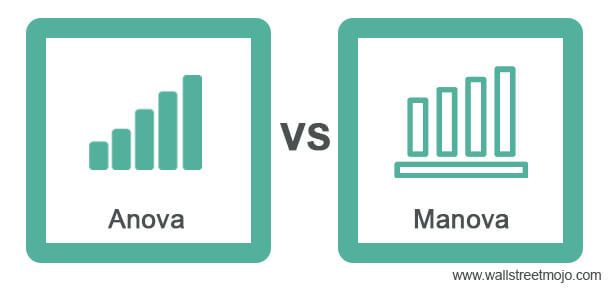Here is a table to represent the ANOVA vs MANOVA comparison. The table includes ANOVA vs MANOVA benefits too.
Table Of Contents
The main difference between ANOVA vs MANOVA is the number of dependent variables. ANOVA uses a single dependent variable for its tests on a single continuous variable to find the difference in means. However, MANOVA utilizes multiple dependent variables to perform the tests on numerous continuous variables to know the effect of the independent variable on the dependent variables. ANOVA has three variants of analysis of the difference in means, whereas Manova has no such models for doing the same.

Key Takeaways
Here is a table to represent the ANOVA vs MANOVA comparison. The table includes ANOVA vs MANOVA benefits too.
| Parameters | ANOVA | MANOVA |
|---|---|---|
| 1. Full-Form | One can read it as an analysis of variants. | One can read it as a multivariant analysis of variants. |
| 2. Meaning | It analyses the difference between 2 or higher numbers of groups in their means based on the single dependent variable. | It analyses the difference between multiple groups in their means based on multiple dependent variables. |
| 3. Objective | The main objective of ANOVA is to determine the differences in the mean of the different groups. | The main objective of MANOVA is to know the effect on the dependent variable due to the independent variable and possible interactions between independent and dependent variables. |
| 4. Nature | It is parametric in nature. | It is non-parametric in nature. |
| 5. Variables | In every case, ANOVA has only a single dependent variable. | If the dependent variable is more than two, then MANOVA is used. |
| 6. Sample size | It requires a minimum sample size of 128. | The larger the sample size better it is for testing. |
| 7. Workings | It works by assessing the ratio between the differences of means of different groups to the difference between variables within the group. | It works in a way that allows the combination of the variable optimally with the dependent metrics into one numeric value that enhances the difference throughout the group. |
| 8. Models | It does have three different models to find the difference in means. | There is no such model used in MANOVA. |
| 9. Result technique | It gives F-statistics as a result of the test. | It does not use F-statistics but uses Wilk’s Lambda. |
| 10. Relationship | ANOVA only uses a single variable and its relationship with the independent variable. | MANOVA deploys the relationship of variance & covariance for its process. |
In ANOVA vs MANOVA, ANOVA is a statistical technique for comparing the differences between samples of two statistical distributions or using the respective means. It calculates the mean of a group involving only a single dependent variable. One uses ANOVA to determine any difference within two groups of variants and to detect the presence of one or more variables in a group. It is a parametric test.
The result of using ANOVA is the F-statistics. F-statistics is that ratio that depicts the differences between the variance within the group and the group variance. As a result, a numerical figure obtained provides the conclusion about the acceptance or rejection of the null hypothesis. If the difference between the means of the group is noticeable, then the null hypothesis is rejected, and the F-ratio would be larger. One can calculate the significant factor by using F-test in ANOVA.
Although it has a lot of uses, it lacks an explanation of the exact pair with different means. Therefore, one can only use it in combination with other statistical tools. In addition, it is limited by the fact that the data set is homogenous. It also does not work when the standard deviation is heterogeneous. Researchers use it in things like statistical research and the effect of social media on product sales.
In ANOVA vs MANOVA comparison, MANOVA is an extension of ANOVA, which measures the impact of independent categorical variables upon numerous dependent continuous variables. It is a process used for comparing the sample means, which are multivariate in statistics. MANOVA is mostly used in the population having more than two variables. It is a non-parametric test.
MANOVA is the generic form of ANOVA and differs from ANOVA in using covariance amongst the outcome variable, which researchers use to test the importance of mean differences statistically. The effectiveness of MANOVA gets affected by:
The method of the MANOVA test can tell the changes in dependent variables due to the independent variables. The significant factor F is determined using Wilk's lambda. It can also determine any interactions occurring among the dependent variables. Moreover, MANOVA is instrumental in assessing the interactions between the independent variables. There is no external model used for MANOVA tests. However, Wilk's Lambda, a type of F-test, is used to get the value of F. Statisticians and researchers generally use it in research of complicated nature, like the effect of intelligence on drug use.
However, MANOVA does not have an advantage and only complicates the tests. Also, the outcome given by it is sometimes confusing.

Although the ANOVA vs MANOVA comparison table represents the differences between the two, they have some similarities too.
ANOVA and MANOVA are statistical tools to measure the means of independent groups having dependent variables. MANOVA is an ANOVA with two or more continuous response variables. M stands for multivariate. So, MANOVA is an extension of ANOVA, finding mean differences. Like ANOVA, MANOVA has both a one-way and a two-way type.
The researchers use them when they want to statistically control the possible effect of a confounding variable (covariate); It statistically removes the effect of the covariate. They can be one way anova, two way anova vs manova, or multivariate (MANCOVA).